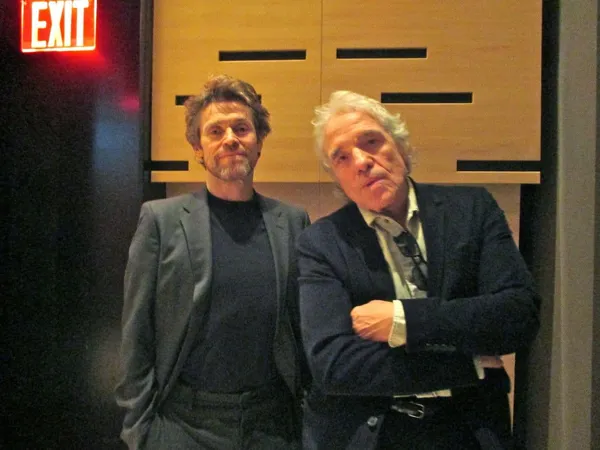 |
| No Exit for Pasolini star Willem Dafoe with director Abel Ferrara: "You know concentric circles." Photo: Anne-Katrin Titze |
Abel Ferrara's Pasolini stars a divine Willem Dafoe as Pier Paolo Pasolini, with Maria de Medeiros, Riccardo Scamarcio, Adriana Asti, Valerio Mastandrea and Giada Colagrande. Developed by Maurizio Braucci from an idea by Nicola Tranquillino and Ferrara, Pasolini begins and ends on one fatal day.
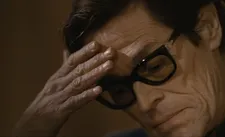 |
| Willem Dafoe as Pier Paolo Pasolini: "It's one thing to show, it's another thing to do." |
Dafoe recently starred in Anton Corbijn's A Most Wanted Man. I asked him if Lars von Trier's Antichrist and Martin Scorsese's Last Temptation Of Christ prepared him for Pasolini's final day. Ferrara told me what that means to him. Fashion, architecture, research, restaurants, apartments and the power of three, pushed our conversation into Abel Ferrara and Willem Dafoe's working relationship upon entering Pasolini's world.
"There is nothing that isn't political," says Pasolini in Ferrara's reconstruction of a final interview, during which the Italian filmmaker is asked why he is no longer militant. The conjuring of a spellbinding narrative of Pasolini's last day on Earth takes the audience from childhood memories, via graphic film clips, to a comet following, unfinished future. Dafoe is caught up in a storm. And a rainbow. Pasolini is shown in all his inconsistencies. Intelligence and style have never been in contradiction to descent into personal hell for Ferrara either.
Abel Ferrara jumps right in with the first question: When did you see the film?
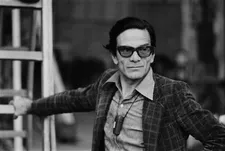 |
| Willem Dafoe on Pier Paolo Pasolini's plaid jacket: "He really mixed and matched in a very creative way." |
Anne-Katrin Titze: Last week at the
Ferrara: And did you like it?
AKT: I did like it. Before I start with my questions, I have greetings to present to you [Willem Dafoe] from Anton Corbijn, who said in an e-mail to me to send you "airport love". He is at an airport hotel in Paris right now.
Willem Dafoe: That sounds good, airport love.
Ferrara: That could be a song.
AKT: "Narrative art is dead, we are in the period of mourning," says Pasolini. Where are we now? Is that something that is of interest to you at all?
Ferrara: It's in the movie, so, considering all the shit he wrote we put that one in there. If we choose 1.0001% of his work, obviously that's some resonance to prove.
AKT: It's a good question.
Ferrara: We like good questions. I hope you're not looking for an answer.
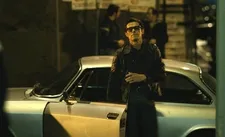 |
| Abel Ferrara's Pasolini, Willem Dafoe on the prowl: "We're filmmakers, man, that's what we do. We re-enact events." |
AKT: Let's go in a completely different direction, then.
Ferrara: No, no, no, that's fine.
AKT: Let's talk about clothes.
Ferrara: Fashion!
Dafoe: Clothes? Okay!
AKT: A waffle pattern white terry-cloth bathrobe. A plaid velvet jacket, you are wearing as Pasolini…
Dafoe: He was a fancy dresser. If you've seen photos of him, man, this guy was a clothes horse. He comes from a place I don't remember. He really mixed and matched in a very creative way.
Ferrara: That jacket was his jacket, though. He [Dafoe] wore his jacket.
Dafoe: I wore some of his clothes.
Ferrara: The pajamas, I don't know. That was his [Dafoe's] choice, the pajamas. Those purple silk striped pajamas, they might have been created by Willem. But hey, they looked good on film. She wants to know the genesis.
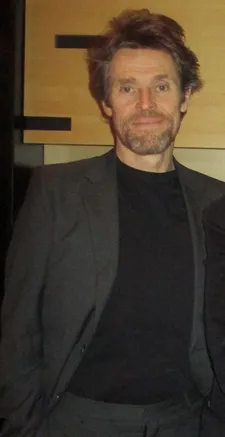 |
| Willem Dafoe: "I knew I became Italian when I woke up in the morning and my first thought is - what am I going to eat?" Photo: Anne-Katrin Titze |
Abel prompts Willem to go into detail.
Dafoe: It was a big work. From what we see, we're not used to it. To go back to what Abel says, you can't film the research. Just because we see it in a photo, doesn't mean it's going to be right on film. At the same time, you take cues from the research and the clothes were a big deal. But we got a lot of help because Ninetto [Davoli] had some clothes of Pasolini's, because obviously they were very close. And he gave me some of the clothes and I fit in.
AKT: What else besides the velvet jacket is the real deal?
Dafoe: There was the jacket, there were the jeans, shirts.
Ferrara: The shirt was a winner. The jacket was a winner. There was a Valentino tuxedo we didn't have a place for but that was a winner. He had some cool shit, man. He was the kind of director who changed two, three times on set. He was like the actors. They'd go to make-up and hair and change and he would be doing the same thing. When you see all those pictures - I don't look like that on a set.
AKT: I liked how the patterns all had this squared, plaid idea, matching the crossroads of the film. Also, the apartment for Pasolini is fantastic. Was that a staged set?
Ferrara: It was right down the block from where he lived. It wasn't staged.
Dafoe: One of the things about Italy is, certain things don't change very much. Those apartments still exist. A certain class of people living in a certain neighborhood. You know it when you see it, when you get in and it feels right.
AKT: Time standing still?
Ferrara: Yes. We basically shot around the corner from where he lived. We were in a real apartment. We had Pasolini's cousin there, Graziella [Chiarcossi], who was a big great gift to us. She was all in. And we tortured her.
Dafoe: She lived with him and we would bring stuff. "Would he wear this?"
Ferrara: We tortured the woman. She didn't even remember.
Dafoe: "Would this fabric look right on this couch?" "Yeah, we had something just like that."
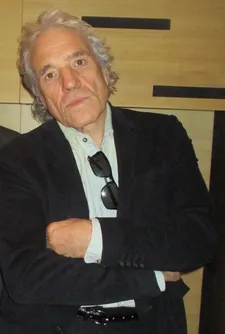 |
| Abel Ferrara: "We like good questions. I hope you're not looking for an answer." Photo: Anne-Katrin Titze |
Ferrara: "And was that chair over there or was that chair over here?"
Dafoe: It was like that. We had a lot of cooperation from his friends and family.
AKT: Didn't Bernardo Bertolucci at some point live in the same apartment building as Pasolini?
Ferrara: No, he must have lived a little above Bertolucci in Monteverde, 15 years before.
AKT: I knew about Pasolini's end. And yet, I jumped in my seat and was completely surprised when it occurred. Were you going for that? Did you want the audience to forget?
Ferrara: It still could have gone in any direction, man. We weren't a lot into the reality of the ending. We could have gone anywhere with that.
AKT: Of course, you could have.
Dafoe: From my perspective, it was a pretty practical approach. Because we didn't want to tip our hand, we didn't want to make a movie about an opinion or a version of his death, I think. [To Ferrara] Hop in any place you like! When we were making that scene, which is mostly action, it was practical and we were balancing certain evidence and certain issues and certain things that we knew and certain things that you couldn't absolutely know, by doing it. It's one thing to show, it's another thing to do. We really had a very practical approach.
Ferrara: The thing is, we re-enacted the murder. What Pasolini said when he was going to write about who killed [Enrico] Mattei [and was asked how he would know] He said, "I'm not a detective, but I'm an artist." When he [Dafoe] is saying practical - there's a way in art. What's the word, technique? We're filmmakers, man, that's what we do. We re-enact events. And it's the truth of that event for the film, which is not a documentary of his murder.
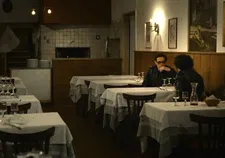 |
| Willem Dafoe on the locations in Pasolini: "You know it when you see it, when you get in and it feels right." |
But you can get to the truth in a lot of different ways. I've made documentaries, and they're not so truthful. And I've made totally imagined films and they seem a lot more truthful when I watch them than the documentaries I did. And I tell you something else, I think the most surprised person in the world that night was him [Pasolini]. I don't think that guy ever imagined he was going to die. Anywhere, anytime, anyplace.
AKT: And you [to Dafoe] captured that perfectly.
Ferrara: And we don't think so either. He'll just jump the bull. That's why he's the fucking villain in fucking Spider-Man. Never mind the fucking kids in the train station.
AKT: Once you're done crawling through the forest with a millstone through your leg [Antichrist] and being crucified [Last Temptation Of Christ], you have become a cat with nine lives.
Ferrara: Crucified, died, and buried, man.
Dafoe: You gotta heat it up!
AKT: The real thing will be…
Dafoe [with a big smile]: I have great practice!
Ferrara: He has all the moves. He knows everything.
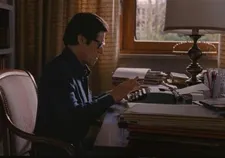 |
| Willem Dafoe on Pasolini's writing: "We were all reading and if we saw something that resonated…" |
AKT: But then, you know, [quoting Pasolini] "the end doesn't exist..."
Dafoe [quoting the rest of the line]: "...let's wait, something will happen."
AKT: Precisely. I liked how the meals were structuring your movie.
Dafoe: I knew I became Italian when I woke up in the morning and my first thought is - what am I going to eat?
AKT: In Pasolini, the two restaurants he goes to that evening represent the two social levels he frequented in his life. Is that course of events based on fact?
Dafoe: Fact.
Ferrara: It's fact enough. Those guys were there. I tell you, in both those restaurants the guys that were there the night he was killed...
Dafoe and Ferrara in unison: …they are still there!
Ferrara: The woman and the guy. All that stuff, it only gets you so far, all that reality, but at least it gets you so far. One leg up. At least we're starting here, we're not starting with Jesus.
Dafoe: For example, you are talking to the guy in the restaurant Pomodoro, and he comes over and says, "he was sitting at this table right here."
AKT: That is in the first restaurant?
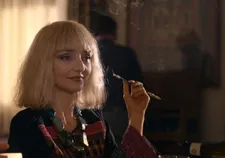 |
| Maria de Medeiros as Laura Betti: "We had a lot of cooperation from his friends and family." |
Dafoe: Yes. So it's like you can shoot there or you can shoot someplace else in the room, but you got to know your reasons for shooting someplace else. So, you are coming up against something. It's not absolute truth. It's just something to work with and that's nice because we were shooting in so many places that were actual.
As a performer, of course, you're flirting with ghosts, and it gives you great power to invest yourself in the scenario you make. But also in the making of the scenario you have those little things you come up against that really help you shape it.
AKT: The choice of which of Pasolini's writings to include, was that a long process?
Ferrara: Long for some people. It was long for us Americans, for these Italians it was a rush job.
AKT [to Dafoe]: Did you have any say in that selection?
Ferrara: He wrote the fucking script!
Dafoe: We were all reading and if we saw something that resonated or we thought was useful, we'd bounce it off the other person.
Ferrara: You know concentric circles. Here is one guy, there you got the writer and here's the space where they connect. And then you got the actor and there's a space where all three connect. And where the writer, the actor and the director connect, unless it's all one person, which he [Dafoe] might do, it's the power of three, where we're all locked in. And that's the movie.





















